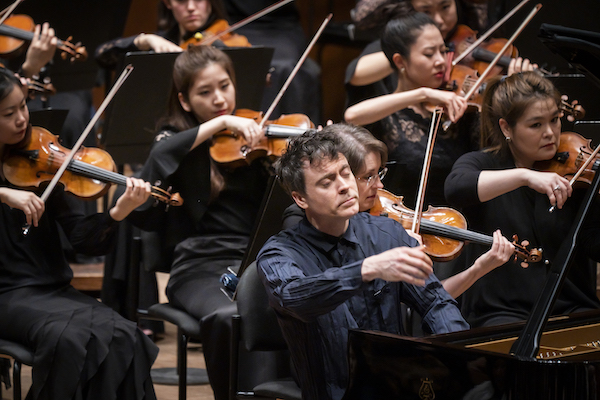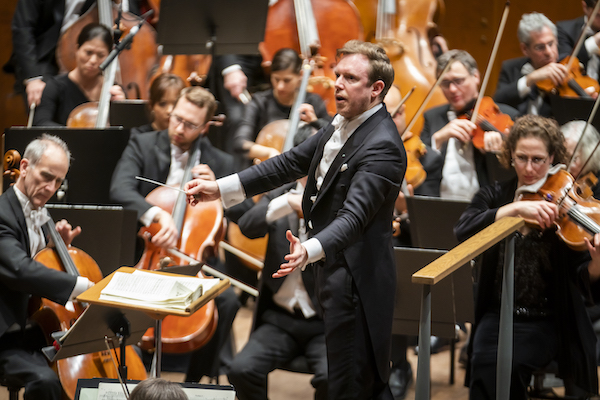Lewis’s Grieg scales the highest peak in Philharmonic program

The New York Philharmonic’s Alpine adventure Thursday night began at the peak.
In a program consisting of just two works, Edvard Grieg’s tuneful Piano Concerto in A minor was apparently intended as the appetizer to Richard Strauss’s vast Alpine Symphony. But in the end, all the admirable exertions of conductor Daniel Harding, an enhanced Philharmonic roster and (it seemed) half the city’s freelance horn players on hand in the Strauss couldn’t displace the memory of pianist Paul Lewis’s revelatory performance of that old familiar.
Lewis’s very presence on Thursday was something of a puzzle. Why was the esteemed interpreter of the headiest creations of Beethoven and Schubert stooping to such pop material? It was as if Dietrich Fischer-Dieskau gave a recital out of the Perry Como songbook.
But it turned out that Lewis’s matchless finger intelligence and sense of a composition’s long arc were just what Grieg’s overfamiliar music needed to spring up anew as an inspired masterpiece.
Grieg himself said his model was Schumann’s Piano Concerto, the most “classical” of Romantic concertos in terms of its logic and flow. Lewis (with Harding firmly on board) seemed to approach the Grieg as if it were Beethoven’s Concerto No. 6, with thrilling results.
From the first page, one sensed the focus and purposefulness of this performance. Lewis launched the piece with a call for attention in craggy chords, and Harding led the exposition with creamy woodwinds on a cushion of strings, its dotted rhythms dancing perfectly in time (not an easy thing, as generations of off-kilter recordings attest).
Lewis’s playing had all the force and fire required for a big Romantic concerto, but also a fine sense of chord voicing and shading even in the most rapid passages. Despite the unfriendly acoustic of Geffen Hall, and even in the softest dynamics, the pianist’s tone was vividly present in the room—no straining to hear what he was doing, a rare experience even among today’s piano superstars.
Harding and the orchestra picked up on Lewis’s long line and swung into their tutti episodes with energy and character.
Lately, when a first movement finishes big, as Grieg’s does, Philharmonic audiences tend to ignore the old rule about not clapping between movements. On Thursday, after the final fortissimo, you could have heard a handkerchief drop. It was as if no one dared break the spell this performance was creating.
That allowed the Adagio’s muted violins to steal in pianissimo, and the movement to grow organically through soft piano musings to a splendid forte return of its tender theme.
Despite Grieg’s cautioning “Allegro moderato molto,” pianist and conductor didn’t entirely resist the urge to rush the finale’s strutting main theme. But the performance was rock-solid rhythmically, with alternately fluent and incisive playing from Lewis. The fast leggiero coda was a delight, and the closing pages as “maestoso” as one could wish. Most in the audience came to their feet at the end, acknowledging the rare gift of a shopworn musical experience made new again.

In contrast, Strauss’s lovable monster of a piece never had a chance to become overfamiliar, owing to the daunting logistics of performing it. (For example, the big-spending composer required twelve offstage horns, for a special effect lasting about a minute.)
As a result, most listeners would have been well-advised not to try to track too closely the piece’s a-day-on-the-mountain scenario, with its 22 continuously played sections (“Night,” “Sunrise,” “Ascent,” “Entering the Forest,” etc.), but instead to surrender to the piece’s musical logic and imagine the natural imagery as it comes along.
Conducting with fluid, embracing gestures, Harding aimed to coax a rich tonal blend from this orchestra, which tends to excel more at a New York brand of brassy brilliance than at Alpine splendor. And if the “Sunrise” resembled more the headlight of an oncoming subway train, the view from “On the Summit” was panoramic with swelling trombones.
Strauss’s skill in composing for a stage-cramming hundred-plus musicians was matched by Harding’s in drawing coordinated, balanced, and characterful playing from them. The piece’s up-and-back, quasi-sonata form, from darkness to darkness with adventures in between, came through clearly. The experience, however, seemed somewhat two-dimensional, more a handsome coffee-table book about the mountain than the mountain itself.
Or perhaps one was just remembering how palpable and in-the-moment everything felt earlier, while listening to Grieg’s concerto.
The program will be repeated 2 p.m. Friday and 8 p.m. Saturday. nyphil.org; 212-875-5656.